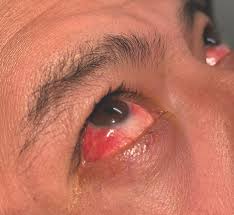Ocular redness, commonly referred to as red eyes, is a visible manifestation of dilated or inflamed blood vessels on the surface of the eye. This condition can range from mild to severe and may signal underlying irritation, inflammation, infection, or trauma. Recognizing the specific cause is essential for appropriate management and for preventing complications that may affect vision or ocular health.

Understanding the Anatomy of Ocular Redness
The eye’s outermost layer, the conjunctiva, contains numerous tiny blood vessels. When these vessels become dilated due to various stimuli, the eye appears red or bloodshot. This redness may be diffuse or localized and can affect one or both eyes depending on the cause.
Common Causes of Ocular Redness
1. Conjunctivitis (Pink Eye)
Conjunctivitis, an inflammation of the conjunctiva, is one of the most frequent causes of red eyes. It can be:
- Viral – highly contagious, associated with watery discharge
- Bacterial – produces yellow-green discharge and lid crusting
- Allergic – accompanied by itching and watery eyes
2. Dry Eye Syndrome
Inadequate tear production or poor tear film quality can lead to dry eye syndrome, causing inflammation and redness due to ocular surface irritation.
3. Subconjunctival Hemorrhage
A sudden rupture of a small conjunctival blood vessel may lead to a subconjunctival hemorrhage—a bright red patch on the white part of the eye—often painless and benign.
4. Blepharitis
Chronic inflammation of the eyelids, known as blepharitis, can lead to persistent redness and irritation due to bacterial buildup and clogged oil glands.
5. Uveitis
Uveitis is a serious inflammation of the uveal tract (iris, ciliary body, and choroid) that can result in deep redness, pain, and light sensitivity. It requires immediate medical attention.
6. Glaucoma
Acute angle-closure glaucoma is a medical emergency that presents with intense eye pain, nausea, blurred vision, and red eyes due to elevated intraocular pressure.
7. Corneal Conditions
Infections, ulcers, or abrasions of the cornea can trigger pronounced redness, tearing, and sensitivity to light.
Symptoms Accompanying Eye Redness
Ocular redness is often accompanied by additional symptoms that help determine the underlying condition:
- Tearing or watery eyes
- Mucous or purulent discharge
- Pain or gritty sensation
- Photophobia (light sensitivity)
- Blurred vision
- Swollen eyelids
- Itching or burning
Diagnostic Approach to Ocular Redness
Proper diagnosis involves a detailed clinical evaluation and patient history:
- Slit-lamp examination to assess conjunctiva, cornea, and anterior chamber
- Fluorescein staining to detect corneal abrasions or ulcers
- Tonometry to measure intraocular pressure
- Allergy or culture tests in persistent or unclear cases
Treatment Strategies for Ocular Redness
Targeted Therapies by Cause
| Condition | Treatment |
|---|---|
| Viral Conjunctivitis | Cold compress, artificial tears, hygiene |
| Bacterial Conjunctivitis | Topical antibiotics (e.g., moxifloxacin, tobramycin) |
| Allergic Conjunctivitis | Antihistamines, mast cell stabilizers |
| Dry Eye Syndrome | Artificial tears, punctal plugs, omega-3 supplements |
| Subconjunctival Hemorrhage | Observation; usually resolves spontaneously |
| Uveitis | Steroid eye drops, cycloplegics, systemic therapy |
| Glaucoma | Carbonic anhydrase inhibitors, beta-blockers, surgery |
| Corneal Ulcers | Intensive antibiotic therapy, cycloplegics |
General Measures
- Avoid eye rubbing, which may worsen inflammation
- Use cool compresses to reduce vessel dilation
- Maintain good eyelid hygiene to manage blepharitis
- Avoid contact lenses until symptoms resolve
- Protect eyes from wind, smoke, and allergens
Preventive Practices to Reduce Risk of Red Eyes
Eye Hygiene and Protective Measures
- Wash hands frequently and avoid sharing towels or cosmetics
- Use protective eyewear in dusty or windy environments
- Limit screen time and follow the 20-20-20 rule
- Keep makeup and eye products clean and replace regularly
- Stay hydrated and maintain balanced nutrition
Environmental Adjustments
- Use humidifiers to combat dry air
- Avoid exposure to smoke and chemical irritants
- Clean indoor spaces regularly to reduce allergens
When to Seek Immediate Medical Attention
Not all cases of ocular redness are benign. Urgent ophthalmic consultation is essential if any of the following occur:
- Severe pain or vision loss
- Persistent redness beyond one week
- History of trauma or chemical exposure
- Pupil abnormalities or light sensitivity
- Redness with systemic symptoms such as joint pain or fever
Frequently Asked Questions:
Q1: Can stress or fatigue cause red eyes?
Yes. Lack of sleep, prolonged screen use, and stress can cause temporary ocular vessel dilation.
Q2: Are red eyes always infectious?
No. While some forms like viral conjunctivitis are contagious, others such as dry eyes or blepharitis are not.
Q3: Should I stop using contact lenses if my eyes are red?
Yes. Discontinue use immediately and consult an eye care provider to avoid corneal damage.
Q4: Is ocular redness a sign of COVID-19?
In rare cases, conjunctivitis may occur with viral infections including COVID-19, but it is not a definitive sign.
Q5: Can I use over-the-counter redness-relief drops?
Occasionally, but frequent use of vasoconstrictor drops can lead to rebound redness and dependency.
Ocular redness is a widespread symptom with a broad differential diagnosis, ranging from benign conditions like conjunctivitis to vision-threatening disorders such as uveitis or glaucoma. A thorough understanding of its causes, careful assessment of associated symptoms, and timely intervention are critical in preserving ocular health. By adopting preventive strategies and seeking expert care when needed, we can manage and mitigate the discomfort and risks associated with red eyes effectively.